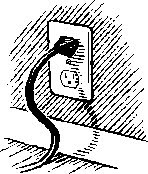Technology Review of December 18, 2009 had an article entitled, Hot Electrons Could Double Solar Power. It's worth a little review of how solar photovoltaic cells work. A PV is essentially two layers of semiconductor material, one of which has an excess of electrons and the other a shortage of electrons. When a photon from the sun hits an electron, it dislodges it, sends it through a curuit, to the other side, creating electricity.
The article discusses how certain of these electrons respond to different wavelengths of sunlight. Some PV cells are adapted to one wavelength or another. In the blue light wavelength of the sun, the electrons have high energy, but it dissipates as heat before it can escape the cell and produce electricity. Researchers are finding ways to make the PV cell sufficiently thin and configured in such a way, as to take advantage of these "hot electrons" and produce much more electricity from a given surface area than the current state of the art of photovoltaics.
In my book, How to Tell a Btu from a BLT, I discuss in my chapter on solar energy the heat transfer mechanism by which the sun's heat is transmitted through the vacuum of space and the fact that PV cells have efficiencies ranging from 8% to 35%. The Technology Review article reports the promise of PVs with an efficiency of 67%. This is an enormous breakthrough in solar technology. It has an enormously positive impact on land use for central station generation using photovoltaics. Moreover, it brings distributed generation using photovoltaics one step further toward reality. One can imagine a the day when a significant portion of household power requirements come from a PV array on one's roof during the day (especially in the Southwest) and we rely on the grid at night. This would relieve a huge burden of building new generation and transmission infrastructure by the nation's electric utilities. But most amazingly, 67% efficiency is a twice the efficiency of the average coal or nuclear steam generating plant that exists today. Now that's progress!
Wednesday, December 23, 2009
Subscribe to:
Post Comments (Atom)




No comments:
Post a Comment